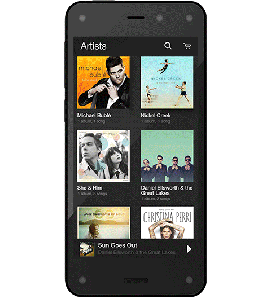In July of 2014, Amazon came out with a smartphone, the Amazon Fire phone. The phone sports 3-D visuals and is tightly integrated into the Amazon ecosystem. For example, the Firefly feature can scan and recognize over 70 million products that the consumer is able to purchase or look up immediately from his or her phone. Additionally, Firefly can identify millions of movies, television shows, books or songs that can also be purchased directly from the phone. When the Fire phone launched in July 2014, it was being offered for sale on Amazon and at Best Buy for between $449 – $650. It was rumored that the Fire Phone cost about $205 to make (PC Magazine, “Amazon’s $650 Fire Phone Costs $205 to Make,” July 29, 2014.)
The phone was widely panned by critics due to its relative lack of apps compared to the Apple App Store and Google Play store, sluggish performance, and short battery life.
In response to the lackluster sales, the Amazon Fire Phone was marked down in fall 2014 and could be purchased for $0.99 on contract ($449 off-contract, but locked to AT&T network; there is no unlocked version for sale.)
At the end of September 2014, Amazon wrote down its remaining inventory of Fire phones by $83 million.
Questions
- What range of expected contribution margins per Fire Phone did Amazon expect when it brought the Fire Phone to market in July 2014?
- What is the contribution margin per Fire Phone when the selling price is $0.99 per phone?
- Is the manufacturing cost of Fire Phones that are already in inventory relevant to the pricing of the phones? Why or why not?
- Generally speaking, companies would not normally want to sell products with a negative contribution margin. Why might Amazon sell phones that originally cost $205 to build for just $0.99 each?
Instructor Resources
These resources are provided to give the instructor flexibility for use of Accounting in the Headlines articles in the classroom. The blog posting itself can be assigned via a link to this site OR by distributing the student handout below. Alternatively, the PowerPoint file below contains a bullet point overview of the article and the discussion questions.
- Student handout (pdf) (word) (contains entire blog posting + discussion questions)
- PowerPoint file (brief article overview + discussion questions)
This work is licensed under a Creative Commons Attribution-NonCommercial 3.0 Unported License.


 November 18, 2014
November 18, 2014 


No comments yet... Be the first to leave a reply!